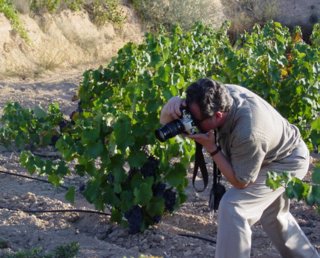Navarra: A Spanish Kingdom's Wines Wear the Versatility Crown

Text & Photographs by Gerry Dawes©2008
Immortalized in the Middle Ages in the French poem Chanson de Roland (whose legendary setting is in the hills above the Pyreneen village of Roncesvalles); its capital Pamplona made famous the world over in the 1920s by Ernest Hemingway in The Sun Also Rises; and again in the 1960s by James A. Michener in Iberia, beautiful, rugged and evocative Navarra is arguably Spain's most versatile wine region.
Located in mountainous north central Spain, Navarra is hemmed to the north by the Pyrenees (and France) to the north/northwest by Basque Country, to the west/southwest by La Rioja and to the east/southeast by Aragón, a climatic range that includes high mountains, green northern zones, the arid Ebro River basin in the south and a desert called Bardenas Reales. These varied climatic influences, which include very important temperate zones provide a breadth of truly great winemaking potential.
Several of its wineries have proven just that: Its first-rate Chardonnays are among the finest in Spain; garnacha-based rosados rank with the best in the world; the cream of Navarra's Bordeaux- and Rioja-style wines (especially from bodegas such as Julián Chivite) stand alongside many of Spain’s most distinguished reds; and late harvest moscatels — Aliaga, Chivite and Ochoa to name three — are counted among the most delicious dessert wines in the country. Navarra even boasts a stunningly good, little-known, old-fashioned vino rancio known as Capricho de Goya that rates in the high 90s on nearly everyone's point scale.
Bodegas Camilo Castilla
Wines have been made here since the Roman occupation, as evidenced in southern Navarra along the Ebro River by the remains of several wineries, such as the one at Funes, that date back more than 2,000 years. In the Middle Ages, Navarra was a sprawling kingdom that included Bordeaux, French Navarre, parts of La Rioja, portions of the Basque Country (mountainous northern Navarra and Pamplona, called Iruña in Basque) and Aragón.

Roman Winery at Funes in Southern Navarra
Navarra's importance was vital in establishing the Camino de Santiago pilgrimage route that buttressed the Christian frontier, especially in the 12th and 13th centuries, when Cistercian monks arrived to establish monasteries and plant vineyards all around northern Spain.
Several of its wineries have proven just that: Its first-rate Chardonnays are among the finest in Spain; garnacha-based rosados rank with the best in the world; the cream of Navarra's Bordeaux- and Rioja-style wines (especially from bodegas such as Julián Chivite) stand alongside many of Spain’s most distinguished reds; and late harvest moscatels — Aliaga, Chivite and Ochoa to name three — are counted among the most delicious dessert wines in the country. Navarra even boasts a stunningly good, little-known, old-fashioned vino rancio known as Capricho de Goya that rates in the high 90s on nearly everyone's point scale.
Read the rest to this 5,000-word article.
About the author
Gerry Dawes was awarded Spain's prestigious Premio Nacional de Gastronomía (National Gastronomy Award) in 2003. He writes and speaks frequently on Spanish wine and gastronomy and leads gastronomy, wine and cultural tours to Spain. He was a finalist for the 2001 James Beard Foundation's Journalism Award for Best Magazine Writing on Wine.
Mr. Dawes is currently working on Mr. Dawes is currently working on a reality television series on wine, gastronomy, culture and travel in Spain..
Experience Spain With Gerry Dawes: Culinary Trips to Spain & Travel Consulting on Spain
Gerry Dawes can be reached at gerrydawes@aol.com Alternate e-mails (use only if your e-mail to AOL is rejected): gerrydawes@optonline.net or gerrydawes@hotmail.com
Labels: Aliaga, Arinzano, garnacha rosados, Julián Chivite, Navarra







